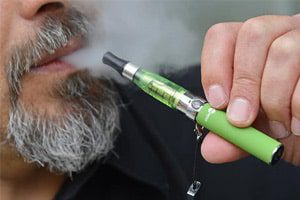
The U.S. Food and Drug Administration (FDA) is facing mounting pressure to regulate e-cigarettes after the federal government recently announced that use of the devices has tripled among young people within one year. Even though the agency has had the authority to regulate all tobacco products since 2009, there are still no rules in place […]

Former FDA Commissioner Says E-Cigarette Regulation Needed
The U.S. Food and Drug Administration (FDA) is facing mounting pressure to regulate e-cigarettes after the federal government recently announced that use of the devices has tripled among young people within one year. Even though the agency has had the authority to regulate all tobacco products since 2009, there are still no rules in place to restrict e-cigarettes. In a New York Times op-ed article, former FDA Commissioner David A. Kessler and Campaign for Tobacco-Free Kids president Matthew L. Myers assert that it is high time for the agency to act.
Kessler and Myers say that the sharp increase in e-cigarettes use among youth is not surprising, given that the devices have been able to dodge federal regulation and are using the same strategies as cigarette companies to get teens hooked. The devices are endorsed by celebrities, and portrayed as glamorous or masculine in TV and magazine ads. E-cigarette makers have also sponsored race cars and music festivals. The devices also come in sweet flavors such as gummy bear and cotton candy.
The FDA proposed new regulations for e-cigarettes last April, but the timeline and final outcome are unclear. The proposed rules would restrict sales to individuals 18 and above. In some states, there are currently no age restrictions. However, Kessler and Myers point out that the proposal does not address how the devices are marketed or the use of appealing flavors. Failing to address these issues is “a big mistake”, the article opines. “The cigarette industry has long understood that virtually all new tobacco users in the United States are children and that if it doesn’t hook them as kids, it probably never will. We can’t let the e-cigarette industry do the same.”
The op-ed article indicates that lax regulations for e-cigarettes can undermine the substantial progress that has been made to reduce smoking among teenagers. The rate of smoking among high school students dropped to a record low 9.2 percent from 67 percent in the last 15 years. But this change may not last if e-cigarette makers continue to have free reign. In 2013, 4.5 percent of high school students used the devices; that figure has already jumped up to 13.4 percent in 2014.
While the effectiveness of e-cigarettes as a cessation tools in adults is unknown, they are certainly harmful in kids. The devices deliver the highly addictive compound nicotine. According to the Centers for Disease Control and Prevention, this addiction is particularly strong in young people. There is also evidence suggesting that nicotine exposure can impact adolescent brain development.
Read more at: Commissioner Says E-Cigs Need To Be Regulated


